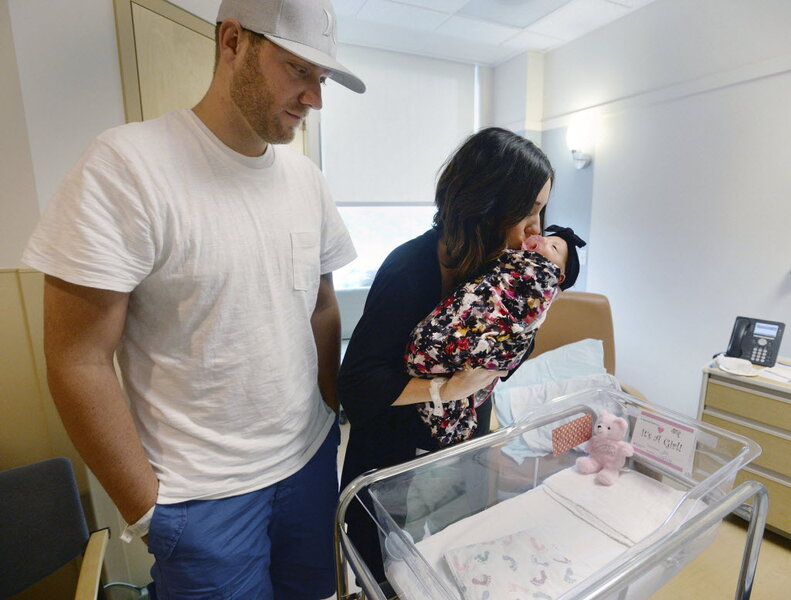As the economy improves, America's birthrate rises
Loading...
As the economy starts to improve, it’s not just interest rates that are going to go higher. The birthrate shoots up, too.
On Tuesday, preliminary data for 2014 released by the National Center for Health Statistics demonstrated that this tell-tale sign of economic recovery is beginning to appear in America. The birthrate in the United States had either remained at a standstill or declined each year since before the start of the Great Recession, but 2014 saw the first increase since 2007. While there are multiple factors that influence birthrate, experts say that the recession-induced decline appears to be coming to an end.
“I suspect certain segments of the population were under stress before the recession started - like construction workers - and even more families were in distress in 2008 through 2012. And this led to fewer babies,” wrote Bill McBride for the finance and economics blog Calculated Risk.
“Of course economic distress isn't the only reason births decline - look at the huge decline following the baby boom that was driven by demographics. But it is not surprising that the number of births slow or decline during tough economic times - but that is over now,” he continued.
According to the preliminary data released by the NCHS, there were 3,985,924 births in the United States in 2014, a 1 percent increase from 2013. The number of births had declined for five consecutive years prior to 2013.
One of the major trends the data revealed is that women are giving birth later in life. Teen pregnancy is at a historic low, as there were only 24.2 births per every 1,000 females between the ages of 15 to 19. That was a 9 percent drop from the previous year. These results are in line with the declining number of teen pregnancies since the 1990s. The number has declined by a whole 61 percent since its peak in 1991, the data reveals.
The birthrate for women between the ages of 20 to 24 also reached a record low in 2014, declining by 2 percent from the previous year to 79 births per 1,000 women. The number of pregnancies for women in this age group has also been declining by over 4 percent a year over the past seven years.
Meanwhile, the birthrate for women between 25 and 29 years of age went flat, despite the fact that it had dropped by over 1 percent in recent years.
Among women 30 and older, however, the number of births shot up. The birthrate for women between the ages of 30 and 34 rose by 3 percent between 2013 and 2014, continuing a trend that began in 2011. In 2014, there were 100.8 births per every 1,000 women in this age group. For women in their mid-late 30s, or those between the ages of 35 to 39, the birthrate also rose by 3 percent from the previous year to 50.9 births per 1000 women, continuing an upward trend that began in 2010.
The birthrate among women between 40 and 44 years of age also rose by 2 percent, to 10.6 births per 1,000 women.
Job security could have a big role to play in why women are waiting to have children, researchers say.
In 2013, at the very end of the global financial crisis, researchers in Adelaide, Australia found that the likelihood women would become mothers by the age of 35 dropped for every year she spent working a temporary job. If a woman had worked as a temp for one year she was 8 percent less likely to be a mother by 35. If she had a temp job for three years, she was 23 percent less likely to have had her first child by that age, and if she spent five years in temporary employment, she was a full 35 percent less likely, the researchers revealed. This was true regardless of the woman’s level of education.
“Our findings suggest that, regardless of their socioeconomic circumstances, women generally aspire to economic security prior to starting a family,” wrote the authors of the study, which was published in the academic journal Human Reproduction.
“We are confident that childlessness is related to employment status, over and above any relationships with socio-economic circumstance,” co-author Lynne Giles, a senior lecturer at the Adelaide university, told Time magazine. “We took the woman’s educational attainment and that of her partner into account in our analyses.”
Now, however, many observers say they are confident that the economic recovery in the United States will also lead to more births.
"By 2016 and 2017, I think we'll start seeing a real comeback," Dr. Aaron Caughey, chair of obstetrics and gynecology for Oregon Health & Science University in Portland, told CBS. "While the economy is doing better, you're still going to see a lag effect of about a year, and 2014 is the first year our economy really started to feel like it's getting back to normal."








